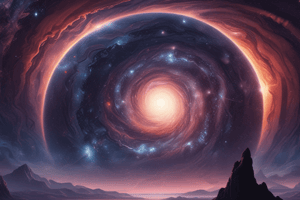Podcast
Questions and Answers
What is the innermost layer of the Sun?
What is the innermost layer of the Sun?
- Photosphere
- Convective zone
- Radiative zone
- Core (correct)
What is the most widely accepted theory of the Moon's formation?
What is the most widely accepted theory of the Moon's formation?
- Capture theory
- Aggression theory
- Fission scenario
- Giant impact theory (correct)
What was the Earth's surface like initially?
What was the Earth's surface like initially?
- Cold and icy
- Hot with seas of lava (correct)
- Temperate with a breathable atmosphere
- Barren and rocky
What is the process that caused the Earth's crust to break apart and form continents?
What is the process that caused the Earth's crust to break apart and form continents?
Why is Pluto no longer considered a planet?
Why is Pluto no longer considered a planet?
What is the region of space where Pluto is located?
What is the region of space where Pluto is located?
What is the name of our galaxy?
What is the name of our galaxy?
What is the main source of light for all the planets in our solar system?
What is the main source of light for all the planets in our solar system?
Which planet is known for its high amount of carbon dioxide?
Which planet is known for its high amount of carbon dioxide?
How long does it take Neptune to revolve around the Sun?
How long does it take Neptune to revolve around the Sun?
What is the surface temperature of the Sun?
What is the surface temperature of the Sun?
What is the largest planet in our solar system?
What is the largest planet in our solar system?
What event triggered the formation of the solar system?
What event triggered the formation of the solar system?
What percentage of the solar system's mass is made up by the Sun?
What percentage of the solar system's mass is made up by the Sun?
Flashcards are hidden until you start studying
Study Notes
Our Galaxy: The Milky Way
- The Milky Way is the galaxy that contains our solar system.
Our Solar System
- The solar system has eight major planets: Mercury, Venus, Earth, Mars, Jupiter, Saturn, Uranus, and Neptune.
- The Sun is the main source of light for all the planets.
- Mercury is the closest planet to the Sun, with a year that is 88 days long.
- Venus is the hottest planet in the solar system due to its high amount of carbon dioxide.
- Earth is a unique planet with suitable climatic conditions, landforms, and water bodies that support life in all forms.
- Mars is often known as the Red Planet due to its reddish appearance.
- Jupiter is the largest planet in our solar system, with a day that is only 9 hours and 55 minutes long.
- Saturn has about 150 frozen moons, including the largest moon, Titan.
- Uranus is a very cold planet, with temperatures dropping to -224 degrees Celsius.
- Neptune takes about 165 Earth years to revolve around the Sun and is known as the Ice Giant.
Formation of the Solar System
- The solar system was formed 4.6 billion years ago when a cloud of dust and gas was disturbed by an explosion of a nearby star.
- The explosion led to the formation of a solar nebula, which eventually formed the Sun, planets, and other solar system bodies.
- The center of the solar nebula became hotter and denser, forming the Sun, while the surrounding material formed the planets and moons.
The Sun
- The Sun is the largest object in our solar system, making up 99% of the solar system's mass.
- The Sun was formed 4.5 billion years ago in the Milky Way galaxy's Orion spur.
- The Sun's surface temperature is about 5,600 degrees Celsius, which increases to 15 million degrees Celsius at the core.
- The Sun is divided into six layers: corona, chromosphere, photosphere, convective zone, radiative zone, and core.
The Moon
- The Moon is the natural satellite of Earth.
- The most widely accepted theory of the Moon's formation is the giant impact theory, which suggests that the Moon was formed when a Mars-sized planet collided with the Earth.
The Earth
- The Earth was formed 4.5 billion years ago, with the universe beginning to cool down and settle into its current layout.
- The Earth's surface temperature was initially very hot, with seas of lava and a poisonous atmosphere.
- The Earth's surface cooled down, and water from the inside of the Earth rose to the surface, forming oceans and eventually creating a thin crust.
- The Earth's crust moved around, breaking apart and creating continents, with the process of plate tectonics.
Pluto
- Pluto is no longer considered a planet, but a dwarf planet.
- Pluto was downgraded from its planetary status because it doesn't meet the third criterion for a planet, which is that the area around its orbit should be clear.
- Pluto was discovered in 1930 by American astronomer Clyde Tombow.
- Pluto is part of the Kuiper belt, which contains other dwarf planets like Haumea, Makemake, and Eris.
Studying That Suits You
Use AI to generate personalized quizzes and flashcards to suit your learning preferences.




